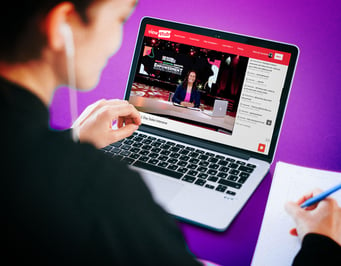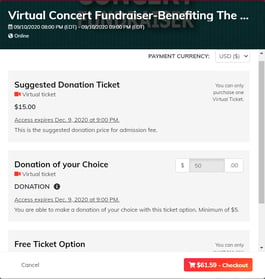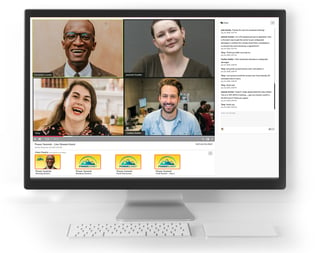Top 10 Essentials to a Successful Virtual or Hybrid Event
 Since the spring of 2020, virtual event platforms have emerged as the hero for keeping organizations and businesses connected to their communities. Events large and small have quickly moved to virtual environments. And organizers are reaping the many of the benefits like connecting with a wider audience and saving attendees time and money by eliminating travel to and from the event.
Since the spring of 2020, virtual event platforms have emerged as the hero for keeping organizations and businesses connected to their communities. Events large and small have quickly moved to virtual environments. And organizers are reaping the many of the benefits like connecting with a wider audience and saving attendees time and money by eliminating travel to and from the event.
As in-person events slowly begin to come back at reduced capacity, the virtual component will continue to bolster them for many reasons. First, we’ve proven we can do it. The world today has quickly become conditioned to digital alternatives. Business travel will be slow to rebound with liability concerns and reduced travel budgets. Therefore, organizers are adapting to the hybrid model for their events.
Some of the biggest challenges event organizers still face with hybrid and virtual events is making them profitable, creating value for attendees and just plain translating their events into the digital environment. So, we’ve compiled a list of the top 10 essentials for planning a virtual or hybrid event.

1. Plan the Virtual Attendee Experience
Even though in-person and remote attendees are taking in the same content from the event, the experience will be different for both. Think about how fans watch a sporting event. The live audience experiences the game surrounded by cheering fans and vendors selling food and beverages – I can smell the popcorn now! They are watching a live event, so if they look away for a few seconds they might miss a crucial play. On the other hand, the fans at home are greeted by the commentators at the beginning of the broadcast. There may be a reporter on the sideline to update fans on an injured player or interview a coach on their strategy. And they won’t miss a crucial play because they will get a replay after nearly every play. You see, there are two different experiences, even for professional events.
Customize the experience for the folks at home. For example, have a moderator in a studio recapping the sessions and revealing what’s coming up next. Plan for content between breaks – broadcast short video vignettes with industry experts during breaks. As another approach, have a roaming reporter interviewing in-person attendees between sessions.
2. Sell Attendance to Online Viewers
 There are numerous reasons you should charge a fee to attend your event virtually. For one thing, it ensures access to only your registered attendees. But more importantly, no one values anything that is free. If they didn’t pay for it, there is no perceived value. People who pay for a ticket are more likely to attend your event because they are vested. And they are more likely to participate and engage in your event. If you are charging your in-person attendees, you should also be charging admission to virtual attendees. So, put an amount to the cost for virtual entry. Additionally, you are saving them time and money they would have spent on traveling to the event location to receive this content.
There are numerous reasons you should charge a fee to attend your event virtually. For one thing, it ensures access to only your registered attendees. But more importantly, no one values anything that is free. If they didn’t pay for it, there is no perceived value. People who pay for a ticket are more likely to attend your event because they are vested. And they are more likely to participate and engage in your event. If you are charging your in-person attendees, you should also be charging admission to virtual attendees. So, put an amount to the cost for virtual entry. Additionally, you are saving them time and money they would have spent on traveling to the event location to receive this content.
Think it can't be done? See how Steve Patrick's Top 1% Mastermind brought in over $154k through a series of 4 online events.
Make it clear that you are offering virtual attendance, what’s included, how they can view it; on-demand or live streaming access. Create multi-tiered or VIP tickets that provide access to upsell sessions. If you are broadcasting a series of events such as weekly sporting events, consider offering a season pass to capture more sales. Highlight all the benefits to attending virtually to paint the picture of your online experience in your pre-event promotion.
3. Establish the Vibe of the Live Event for Remote Attendees
 Close the gap between in-person and virtual attendees. If you're hosting a multi-day conference, capture footage of the live experience; the arrival, registration, networking, breaks between sessions, walking into the general session, etc. Use this footage to create daily video spots to broadcast online between sessions to give online viewers a taste of the onsite ambiance. Besides, you should be capturing footage to use to promote next year’s event.
Close the gap between in-person and virtual attendees. If you're hosting a multi-day conference, capture footage of the live experience; the arrival, registration, networking, breaks between sessions, walking into the general session, etc. Use this footage to create daily video spots to broadcast online between sessions to give online viewers a taste of the onsite ambiance. Besides, you should be capturing footage to use to promote next year’s event.
Create a pre-event video showing landmarks in and around your event’s destination to use as the establishing shot for your introduction to your remote attendees. Your convention and visitor’s bureau should provide stock footage that you can use.

4. Create a Remote Charity Event
Everyone feels good about supporting a cause, and most people won’t hesitate to donate to a justifiable effort. Adding a charity component to your event raises awareness for the cause, plus contributes money to support the effort. It shows you took the time to lead the efforts to assist those in need, which can also help you earn brand loyalty.
Create an online experience that will resonate with your audience such as exclusive access to a Q&A session with an industry expert, or sell raffle tickets for a meet & greet with a celebrity speaker. Set a goal for contributions and communicate the status of reaching that goal during the event. Generate excitement upon reaching that goal and make it happen.

5. Sell Replay Access to Key Sessions on your Website
Create a digital library of your event content to nurture website visitors to attending the full event next time. Replays are great for educational events, giving attendees the opportunity to watch at their convenience. They're also an excellent way to grow a fan base for entertainment events. Wait, why would you do that? Won’t that jeopardize attendance for next year’s event? Nope. First of all, I said “key sessions”. You’re giving your website visitors an appetite for your event content. And you’re selling on-demand access to this content – demonstrating perceived value.
6. Collect Data on Virtual Engagement
One huge benefit to online events is that you can easily capture all kinds of data. Organizers jump through hoops to gather data from in-person events, which is even more of a struggle when it’s collected from different sources and platforms. Virtual attendee data on the contrary, is already digitized.
Use this data to learn more about your audience, how you can improve on your events, where and how you should be promoting your events. Data is valuable to sponsors as well – number of impressions, clicks and firmographic segmentation are all important to them. Create value for your sponsorship packages through your valuable attendee data.
7. Leverage Advocates, Partners and Speakers to Promote the Event
Expand your reach into your community. Create affiliate links for industry advocates and partners to promote the event. Track the success of their efforts and offer a referral incentive on those tickets sold. Encourage your speakers to promote their sessions to their social media audiences and marketing channels to maximize attendance.

8. Event Branding
(and white label)
Leverage your online event to promote brand awareness. This is super important for the digital version of your event. Consistent event branding reinforces your message and helps grow brand advocacy.
When selecting a virtual platform, explore customization features like changing the user interface to your brand colors. Consider a platform that allows you to white label your video stream and embed your virtual event on your own website. Create an immersive experience that enables attendees to live and breathe your brand.
9. Amp Up the Virtual Interaction
One main reason people attend events is to interact with others in their industry. Supplement virtual attendee interaction by adding various opportunities to provide feedback throughout the viewing experience. Consider how social media apps make it easy to provide feedback within their platforms; “like” buttons, the “thumbs up” emoji, fields that allow brief comments, etc.
Here are a few additional ways to create simple interaction:
- Ask trivia questions throughout the event
- Test knowledge after each session with a pop quiz
- Poll attendees between sessions
The key is to make it easy to interact, then post the results in real time.
10. Live Stream a Kickoff of the Virtual Event
 Host a live kickoff the day before the event. This is a great way to get everyone excited and in the mindset for the event. Have an industry expert or celebrity speaker make an appearance or have a Q&A session. Send out a pre-event survey and reveal the results at the kickoff. Offer sponsorship for the kickoff and include a game or group activity for unique sponsor exposure. It’s also one more opportunity to upsell your VIP passes before the event. The kickoff event should be fun and memorable.
Host a live kickoff the day before the event. This is a great way to get everyone excited and in the mindset for the event. Have an industry expert or celebrity speaker make an appearance or have a Q&A session. Send out a pre-event survey and reveal the results at the kickoff. Offer sponsorship for the kickoff and include a game or group activity for unique sponsor exposure. It’s also one more opportunity to upsell your VIP passes before the event. The kickoff event should be fun and memorable.
Many of these tips will work with just about every event type. Consider adding a few of these ideas to improve the experience of your next event.
Final Thoughts
As the world continues to lean on technology to push businesses forward and keep us all connected, virtual and hybrid events will continue to play a key role. Planning the virtual experience for your hybrid event just takes a little time and creativity. Get out there and make your event your own. Speak to one of our event specialists to see how ViewStub can help you reach your event goals.

About ViewStub
ViewStub is a virtual and hybrid event platform that makes it easy for event organizers to sell tickets to live events or sell access to pre-recorded sessions right from their website. ViewStub‘s all-in-one platform offers ticketing, registration, video streaming and new revenue opportunities for creators seeking to monetize their content and grow their community.


